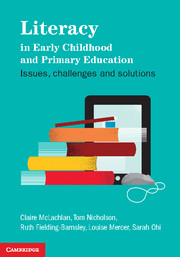Book contents
- Frontmatter
- Contents
- List of figures
- List of tables
- About the authors
- Acknowledgements
- Chapter 1 Introduction
- Part 1 Literacy acquisition: the child, the family and diversity in the modern world
- Part 2 Learning about literacy in early childhood settings
- Part 3 Literacy learning in the primary school
- Chapter 10 The first year of primary school: building on foundations
- Chapter 11 Establishing a community of readers
- Chapter 12 Uses of assessment in the primary school years
- Chapter 13 Reading and writing in the primary school: focus on narrative writing
- Part 4 Literacy learning in the senior primary school
- References
- Index
Chapter 13 - Reading and writing in the primary school: focus on narrative writing
from Part 3 - Literacy learning in the primary school
- Frontmatter
- Contents
- List of figures
- List of tables
- About the authors
- Acknowledgements
- Chapter 1 Introduction
- Part 1 Literacy acquisition: the child, the family and diversity in the modern world
- Part 2 Learning about literacy in early childhood settings
- Part 3 Literacy learning in the primary school
- Chapter 10 The first year of primary school: building on foundations
- Chapter 11 Establishing a community of readers
- Chapter 12 Uses of assessment in the primary school years
- Chapter 13 Reading and writing in the primary school: focus on narrative writing
- Part 4 Literacy learning in the senior primary school
- References
- Index
Summary
Chapter objectives
To explain the structure of stories.
To explain how reading links to writing.
To explain how to instruct a pupil to write a story.
This chapter examines the research evidence on the powerful reciprocal relationship that exists between reading and writing development, the teacher’s role in supporting pupils’ emerging reading and writing abilities, ideas to inspire pupils to use reading as a springboard for writing, and the secrets of success in effective story writing.
Setting the scene
You are a teacher of a Year 1 class. Where do you start in teaching writing? Many teachers connect their teaching of writing to productive talk where the pupils talk together about a topic and generate ideas. Children and teacher talk together about a topic and this leads to writing. The following is an example where the teacher is sitting in front of the class and the class is sitting on the mat.
Example 13.1
A Year 1 class (fi ve-year-olds) writing a story after oral discussion
Time: 9:30
Teacher: ‘Today we are talking about “My family”. Whose family?’
Class: ‘My family!’
Teacher: ‘Talk with the classmate sitting next to you about your family. Who is in your family? Share your ideas.’ ...
- Type
- Chapter
- Information
- Literacy in Early Childhood and Primary EducationIssues, Challenges, Solutions, pp. 234 - 250Publisher: Cambridge University PressPrint publication year: 2012

